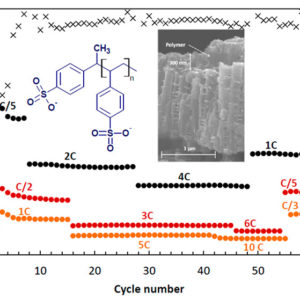Abstract
The cathodic deposition of poly(styrene sulfonate) on nanoarchitectured TiO2 electrodes is explored by cyclic voltammetry and potentiostatic and galvanostatic experiments, showing a diffusion-controlled deposition described by Cottrell’s law. The structure and composition of the polymer is evidenced by various spectroscopic techniques, including nuclear magnetic resonance, Fourier transform infrared, and X-ray photoelectron spectroscopy, and its morphology is studied by scanning electron microscopy. The average chain length can be estimated from the NMR spectra. The electropolymerization mechanism initiates by radical anion formation. The cycling behavior in half-cell batteries against Li metal is excellent, especially at high rates explored up to 10 C. The areal insertion capacity is above recent literature results, up to 80 μA h cm-2. The combination of normalized areal power density and areal energy density is one of the best reported in the literature.
Illustrations
Details
Published on: ACS Applied Materials & Interfaces 2017, 9, 22902-22910
Authors: M. Braglia, I. V. Ferrari, T. Djenizian, S. Kaciulis, P. Soltani, M. L. Di Vona, P.Knauth
